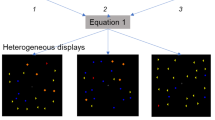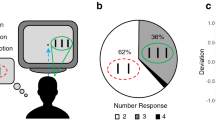Abstract
When you see a red ball rolling across the floor, the ball's redness, roundness and motion appear to be unified and inseparably bound together as features of the ball. But neurophysiological evidence indicates that visual features such as colour, shape and motion are processed in separate regions of the brain1. Here we describe an illusion that exploits this separation, causing colour and motion to be recombined incorrectly while a stable stimulus is being viewed continuously.
Similar content being viewed by others
Main
The illusion is seen in stimuli containing two sheets of random dots, where one sheet is moving up and one is moving down. The sheets contain dots of two colours such that the central and peripheral portions of the stimuli combine colour and motion in opposite fashions (Fig. 1a). On the upward-moving sheet, dots in the centre are red and dots in the periphery are green. On the downward-moving sheet, dots in the centre are green and dots in the periphery are red. (For movie, see supplementary information.)
a, Sample transparent motion stimulus. Two sets of random dots move rigidly in opposite directions. ‘Real’ circles show details of the physical stimulus. In the upward-moving surface, dots near fixation are red, and dots beyond 6° of horizontal eccentricity are green; in the downward-moving surface, the reverse coloration applies. White bars marked the transition line. ‘Perceived’ circles show details of the illusory percept. Observers incorrectly pair colour and motion in the periphery. Across the entire stimulus, upward-moving dots appear red and downward-moving dots appear green, forming two homogeneous surfaces of dots moving in opposite directions. b, Proportion of trials in which observers judge that most red dots beyond the white bars are moving upwards, plotted as a function of the actual percentage of red dots moving upwards; time to view stimuli was unlimited. In control trials (black line), the central region is blank, and responses follow the stimulus. When the central region contains upward-moving red dots and downward-moving green dots (red line), responses shift predominantly to ‘up’. When the central region contains the opposite motion (green line), responses shift predominantly to ‘down’.
Observers gazing at the centre of the display perceive peripheral dots erroneously: they ‘bind’ colour and motion in the wrong combination. The entire display therefore appears to be covered by a sheet of red dots that are moving upwards and a sheet of green dots that are moving downwards.
To quantify this effect, observers were asked to report whether the majority of peripheral red dots were moving up or down over a series of trials in which we varied the percentage of peripheral dots moving in either direction. In control trials, where the central portion of the stimulus was omitted, responses of observers (n = 5; 3 naive) roughly followed the physical stimulus (Fig. 1b, black line). But when the central portion was present, responses shifted markedly, and in the same direction as the central dots (Fig. 1b, red and green lines; MANOVA, F(10,16) = 35.2, P<0.001).
To ensure that observers' responses were reflecting their perception and not a simple bias to respond to the central dots, we generated stimuli in which one peripheral region matched the centre and the other contained the opposite motion. Observers (n = 4; 3 naive; all from the first experiment) perceived both sides to move with the centre, performing poorly in reporting which side moved the other way (mean ± s.e.m.: 47 ± 8% correct; sensitivity measure d′ = −0.12 ± 0.38). On the other hand, they performed well in reporting which side was which when the stimulus centre was blank (86 ± 2.5% correct; d′ = 1.5±0.2, paired t-test P<0.5).
We propose that the illusion described here is the result of an ambiguity-resolving mechanism. Because vision is clearest at the point of gaze, it would normally be advantageous to use information from the centre to resolve peripheral ambiguity if the physical source is likely to be a common uniform surface. Uniform surfaces are strongly implied by the contiguous and precisely equal values of colour and motion present across this stimulus. Peripheral features are bound in such a way as to accord with the usually more reliable centre, although in this case the binding is mistaken.
Previous investigations of basic visual feature binding required the use of stimuli with brief presentation times or rapidly changing features to induce errors or inefficiencies2,3,4. The illusion presented here occurs despite fully attentive and continuous viewing, avoiding the common confounds of memory, expectation and task strategy5. It solidifies the evidence for the existence of a binding problem and provides a substrate for neurophysiological investigation.
References
Livingstone, M. & Hubel, D. Science 240, 740–749 (1988).
Treisman, A. M. & Gelade, G. Cogn. Psychol. 12, 97–136 (1980).
Moutoussis, K. & Zeki, S. Proc. R. Lond. B 264, 393–399 (1997).
Nishida, S. & Johnston, A. Curr. Biol. 12, 359–368 (2002).
Wolfe, J. M. & Cave, K. R. Neuron 24, 11–17 (1999).
Author information
Authors and Affiliations
Corresponding author
Ethics declarations
Competing interests
The authors declare no competing financial interests.
Supplementary information
Supplementary Movie
Steady-state misbinding illusion movie file. The sheets of dots moving past each other appear to be uniformly coloured. However, dots in the periphery actually have reversed colouration. (MOV 1157 kb)
Supplementary Instructions
Instructions for viewing steady-state misbinding illusion movie file. (DOC 20 kb)
Rights and permissions
About this article
Cite this article
Wu, DA., Kanai, R. & Shimojo, S. Steady-state misbinding of colour and motion. Nature 429, 262 (2004). https://doi.org/10.1038/429262a
Issue Date:
DOI: https://doi.org/10.1038/429262a
This article is cited by
-
Neural mechanisms of feature binding
Science China Life Sciences (2020)
Comments
By submitting a comment you agree to abide by our Terms and Community Guidelines. If you find something abusive or that does not comply with our terms or guidelines please flag it as inappropriate.




